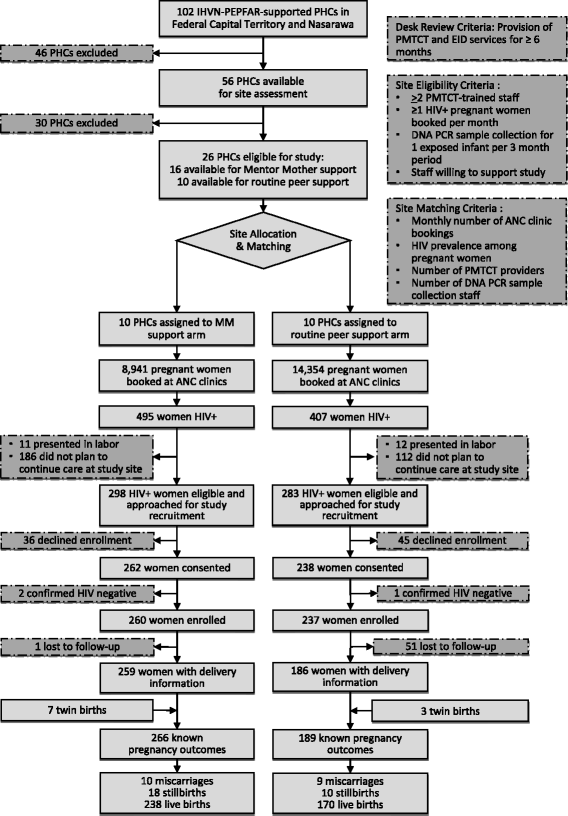Correlates of facility delivery for rural HIV-positive pregnant women enrolled in the MoMent Nigeria prospective cohort study
- PMID: 28705148
- PMCID: PMC5512933
- DOI: 10.1186/s12884-017-1417-2
Correlates of facility delivery for rural HIV-positive pregnant women enrolled in the MoMent Nigeria prospective cohort study
Abstract
Background: Low rates of maternal healthcare service utilization, including facility delivery, may impede progress in the prevention of mother-to-child transmission of HIV (PMTCT) and in reducing maternal and infant mortality. The MoMent (Mother Mentor) study investigated the impact of structured peer support on early infant diagnosis presentation and postpartum maternal retention in PMTCT care in rural Nigeria. This paper describes baseline characteristics and correlates of facility delivery among MoMent study participants.
Methods: HIV-positive pregnant women were recruited at 20 rural Primary Healthcare Centers matched by antenatal care clinic volume, client HIV prevalence, and PMTCT service staffing. Baseline and delivery data were collected by participant interviews and medical record abstraction. Multivariate logistic regression with generalized estimating equation analysis was used to evaluate for correlates of facility delivery including exposure to structured (closely supervised Mentor Mother, intervention) vs unstructured (routine, control) peer support.
Results: Of 497 women enrolled, 352 (71%) were between 21 and 30 years old, 319 (64%) were Christian, 245 (49%) had received secondary or higher education, 402 (81%) were multigravidae and 299 (60%) newly HIV-diagnosed. Delivery data was available for 445 (90%) participants, and 276 (62%) of these women delivered at a health facility. Facility delivery did not differ by type of peer support; however, it was positively associated with secondary or greater education (aOR 1.9, CI 1.1-3.2) and Christian affiliation (OR 1.4, CI 1.0-2.0) and negatively associated with primigravidity (OR 0.5; 0.3-0.9) and new HIV diagnosis (OR 0.6, CI 0.4-0.9).
Conclusions: Primary-level or lesser-educated HIV-infected pregnant women and those newly-diagnosed and primigravid should be prioritized for interventions to improve facility delivery rates and ultimately, healthy outcomes. Incremental gains in facility delivery from structured peer support appear limited, however the impact of duration of pre-delivery support needs further investigation. Religious influences on facility delivery and on general maternal healthcare service utilization need to be further explored.
Trial registration: ClinicalTrials.gov number NCT01936753 , registered September 2013.
Keywords: HIV; Mentor mothers; Nigeria; Pregnancy; Rural populations; Vertical transmission.
Conflict of interest statement
Ethics approval and consent to participate
The study was approved by the Nigerian National Health Research Ethics Committee, the Ethics Review Committee of the World Health Organization, and the Institutional Review Board of the University of Maryland Baltimore and the University of Georgia Athens. Written informed consent was obtained from all study participants.
Consent for publication
Not applicable.
Competing interests
The authors declare that they have no competing interests.
Publisher’s Note
Springer Nature remains neutral with regard to jurisdictional claims in published maps and institutional affiliations.
Figures
Similar articles
-
Acceptability of mentor mother peer support for women living with HIV in North-Central Nigeria: a qualitative study.BMC Pregnancy Childbirth. 2021 Aug 7;21(1):545. doi: 10.1186/s12884-021-04002-1. BMC Pregnancy Childbirth. 2021. PMID: 34364384 Free PMC article. Clinical Trial.
-
The Impact of Structured Mentor Mother Programs on 6-Month Postpartum Retention and Viral Suppression among HIV-Positive Women in Rural Nigeria: A Prospective Paired Cohort Study.J Acquir Immune Defic Syndr. 2017 Jun 1;75 Suppl 2:S173-S181. doi: 10.1097/QAI.0000000000001346. J Acquir Immune Defic Syndr. 2017. PMID: 28498187
-
"They do not see us as one of them": a qualitative exploration of mentor mothers' working relationships with healthcare workers in rural North-Central Nigeria.Hum Resour Health. 2018 Sep 10;16(1):47. doi: 10.1186/s12960-018-0313-9. Hum Resour Health. 2018. PMID: 30200969 Free PMC article.
-
Mental health of HIV-seropositive women during pregnancy and postpartum period: a comprehensive literature review.AIDS Behav. 2014 Jun;18(6):1152-73. doi: 10.1007/s10461-014-0728-9. AIDS Behav. 2014. PMID: 24584458 Free PMC article. Review.
-
Systematic review of research focused on pregnant and postpartum women living with HIV: A relational ethics perspective.Bioethics. 2021 Oct;35(8):829-838. doi: 10.1111/bioe.12917. Epub 2021 Jul 28. Bioethics. 2021. PMID: 34318957 Free PMC article.
Cited by
-
Incidence of home delivery among women living with HIV in Lira, Northern Uganda: a prospective cohort study.BMC Pregnancy Childbirth. 2021 Nov 10;21(1):763. doi: 10.1186/s12884-021-04222-5. BMC Pregnancy Childbirth. 2021. PMID: 34758766 Free PMC article.
-
A mixed-methods assessment of disclosure of HIV status among expert mothers living with HIV in rural Nigeria.PLoS One. 2020 Apr 30;15(4):e0232423. doi: 10.1371/journal.pone.0232423. eCollection 2020. PLoS One. 2020. PMID: 32353036 Free PMC article.
-
Optimization of the vertical transmission prevention program in Guinea: impact of the improvement plan on performance indicators at large-cohort sites.AIDS Res Ther. 2024 Aug 24;21(1):55. doi: 10.1186/s12981-024-00639-y. AIDS Res Ther. 2024. PMID: 39182113 Free PMC article. Review.
-
Generating evidence for health policy in challenging settings: lessons learned from four prevention of mother-to-child transmission of HIV implementation research studies in Nigeria.Health Res Policy Syst. 2018 Apr 17;16(1):32. doi: 10.1186/s12961-018-0309-x. Health Res Policy Syst. 2018. PMID: 29665809 Free PMC article.
-
Experiences, perceptions and potential impact of community-based mentor mothers supporting pregnant and postpartum women with HIV in Kenya: a mixed-methods study.J Int AIDS Soc. 2021 Nov;24(11):e25843. doi: 10.1002/jia2.25843. J Int AIDS Soc. 2021. PMID: 34797955 Free PMC article.
References
-
- UNAIDS, UNICEF. Global and Regional Trends: EMTCT Current Status and Progress. 2015; Available from: http://data.unicef.org/HIVAIDS_2015%20Statistical%20Tables%20(1)_17191ae.... Accessed 2 July 2016.
-
- UNAIDS. On the Fast Track to an AIDS Free Generation: The Incredible Journey of the Global Plan Towards the Elimination of New HIV Infections among Children by 2015 and Keeping Their Mothers Alive. 2016. Available from: http://emtct-iatt.org/wp-content/uploads/2016/06/GlobalPlan2016_en.pdf. Accessed 15 Apr 2017.
-
- UNAIDS. Report on the Global AIDS Epidemic. 2016; Available from: http://www.unaids.org/sites/default/files/media_asset/20160627_HIV2016Es.... Accessed 24 May 2017.
-
- Landesman SH, Kalish LA, Burns DN, Minkoff H, Fox HE, Zorrilla C, et al. Obstetrical factors and the transmission of human immunodeficiency virus type 1 from mother to child. The women and infants transmission study. N Engl J Med. 1996;334(25):1617–1623. doi: 10.1056/NEJM199606203342501. - DOI - PubMed
MeSH terms
Associated data
LinkOut - more resources
Full Text Sources
Other Literature Sources
Medical



